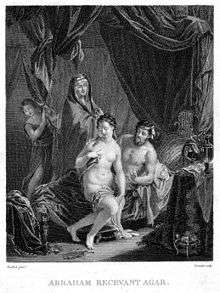Pilegesh

Pilegesh (Hebrew: פִּילֶגֶשׁ) is a Hebrew term for a concubine with similar social and legal standing to a recognized wife, often for the purpose of producing offspring.
The Torah may distinguish concubines and "sub-standard" wives with the prefix "to" (e.g., lit. "took to wives").[1]
Etymology
The term pilegesh comes from a non-Hebrew, non-Semitic loanword deriving from the Greek word pallakis (Greek παλλακίς)[2][3][4] meaning a mistress staying in house; there is a common but unfounded view that it derives from the Aramaic phrase plag isha, meaning half-wife.
In contemporary Israeli Hebrew, the word "pilegesh" is often used as the equivalent of English "mistress"—i.e. the female partner in extramarital relations even when these relations have no legal recognition.
Biblical references
Several biblical figures had concubines when they were not able to create natural children with their wives. The most famous example of this was with Abraham and Sarah. Sarah, gave her maidservant Hagar to Abraham, while maintaining ownership of both maidservant and offspring. Their union produced Ishmael. Hagar gained the status of full wife in regards to Abraham, but nonetheless Sarah retained the status of main wife. Subsequently Isaac inherited Ishmael and Hagar along with the inheritance since under Hebrew law all property of a slave belongs to the master. This type of pilegesh is recorded in Jewish sources as being a singular case. All later cases of pilegesh recognized the pilegesh and guaranteed similar rights in the house as the legitimate wife. Since having children in Judaism was considered a great blessing, legitimate wives often gave their maids to their husbands so they could have children with them when those women themselves where childless, as in the cases of Leah and Zilpah; and Rachel and Bilhah. The concubine commanded the same respect and inviolability as the wife, and it was regarded as the deepest dishonor for the man to whom she belonged if hands were laid upon her. Even in the exceptional case of Sarah and Hagar, Abraham would have been obligated to treat Hagar as a full wife and she would have been treated as an equal by Abraham. Sarah's rights would have been regarding the technical legal status of being considered the inheritor and since the other wife and offspring would have been hers by ownership she became the legal albeit not biological mother of Ishmael. Orach Chaim: Laws of the Handmaiden.
Both forms of marriage involve the death penalty for adultery under Jewish Law.
Legal characteristics
According to the Babylonian Talmud[5] (Sanh. 21a), the difference between a pilegesh and a full wife was that the latter received a marriage contract (Hebrew:ketubah) and her marriage (nissu'in) was preceded by a formal betrothal ("kiddushin"), which was not the case with the former. According to R. Judah, however, the pilegesh should also receive a marriage contract, but without including a clause specifying a divorce settlement.[5]
Certain Jewish thinkers, such as Maimonides, believed that concubines are strictly reserved for kings, and thus that a commoner may not have a concubine; indeed, such thinkers argued that commoners may not engage in any type of sexual relations outside of a marriage.
Maimonides was not the first Jewish thinker to criticise concubinage; for example, it is severely condemned in Leviticus Rabbah.[6] Other Jewish thinkers, such as Nahmanides, Samuel ben Uri Shraga Phoebus, and Jacob Emden, strongly object to the idea that concubines should be forbidden.
Any offspring created as a result of a union between a pilegesh and a man were on equal legal footing with children of the man and his wife. The only exception was the unique relationship between Abraham, Sarah, Hagar, and Isaac and Ishmael.
According to Rabbi Mnachem Risikoff, the institution of pilegesh is an alternative to formal marriage which does not have the same requirements for a Get upon the dissolution of the relationship.[7]
See also
References
- ↑ Women, similar to wives from vadimcherny.org
- ↑ Michael Lieb, Milton and the culture of violence, p. 274, Cornell University Press, 1994
- ↑ Marc Lee Raphael, Agendas for the study of Midrash in the twenty-first century, p. 136, Dept. of Religion, College of William and Mary, 1999
- ↑ Nicholas Clapp, Sheba: Through the Desert in Search of the Legendary Queen, p. 297, Houghton Mifflin, 2002
- 1 2 Staff (2002–2011). "PILEGESH (Hebrew, ; comp. Greek, παλλακίς).". Jewish Encyclopedia. JewishEncyclopedia.com. Retrieved 13 June 2012.
- ↑ Leviticus Rabbah, 25
- ↑ Between Civil and Religious Law: The Plight of the Agunah in American Society, Irving Breitowitz, Greenwood Press, 1993. By coincidence, Breitowitz's book was reviewed by Risikoff's grandson, Rabbi Steven Resnicoff, in Jewish Action, Winter 1994, Vol. 55, No. 2.
- Kosher sex without marriage Jpost By Mathew Wagner
- "ISO: Kosher Concubine" New York Jewish Week by Adam Dickter December 2006
- The Concubine Connection The Independent, London, October 20, 1996, Suzanne Glass